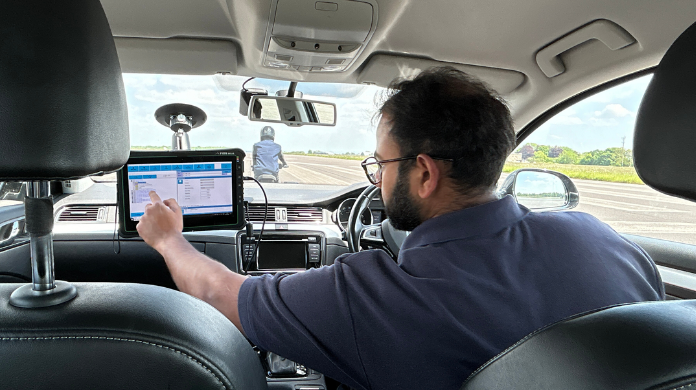The Soft Pedestrian 360 is a next-generation pedestrian ADAS target developed to significantly decrease the time and cost of testing while offering greater realism.

Together with sister company Dynamic Research, Inc. (DRI), we are delighted to announce the launch of the Soft Pedestrian 360™, the latest product in our growing range of ADAS targets. DRI are track test experts and their experience working with the world’s leading safety organisations and OEMs has been critical in the development of the Soft Pedestrian 360.
The product launch will kick-off with a webinar hosted by DRI’s Jordan Silberling, Product Development Director, on the 9th Feb. During the webinar, Jordan will discuss why a more advanced pedestrian target is needed by the market and how the new Soft Pedestrian 360’s design has been carefully considered to meet customer needs.
The key features of the Soft Pedestrian 360 include:
- Active articulation at the hip, knee, shoulder and neck for realistic movement
- Softened contact points that minimise the potential for vehicle damage to test vehicles
- Motion servo design preventing back drive when impacted
- Long battery charge for uninterrupted testing
- ISO 19206 Part 2 compliant
We are particularly proud of the target’s realism, which has been achieved through active articulation of limbs providing more human-like movement, and its focus on minimising damage to vehicles under test.
Joseph Kelly, Chief Engineer at DRI points out: “Damage to the vehicle under test caused by targets can be a substantial contributor to the total cost of testing ADAS technologies. It isn’t just the damage to the test vehicle but also lost track and engineering time waiting for repairs that substantially increase the cost of testing. For example, if a windshield is damaged, camera systems located behind it often require recalibration, which is time-consuming and costly. We have specifically designed the Soft Pedestrian 360 to minimise the risk of damage to the test vehicle.”
The key to reducing the potential for damage to the test vehicle is the target’s compliance, the minimisation of external hardpoints and the modularity of the design, which reduces the mass of any individual component that could contact the test vehicle and cause damage. The limbs, head and mounting pole attach to the torso via foam blocks that engage corresponding sockets in the torso, such that when these components separate on impact, there are no exposed hard points.
The durability of the product has been improved using a novel slipper clutch that stops the servos from being back-driven during a collision avoiding damage. The target is also covered in a hard-wearing fabric clothing that prevents the foam core from being worn away or torn apart, maintaining a consistent shape throughout testing. The clothing can be easily and cost-effectively replaced should it become damaged.
“Efficient use of track time is critical to keeping costs down and maximising the uptime of both the test vehicle and the test equipment is a critical part of this,” said Joseph. “Before we developed our own pedestrian target, we were regularly changing and repairing servos as a result of damage, and this significantly impacted the test schedule. Our solution aims to make ADAS testing as efficient as possible.”
For increased realism the Soft Pedestrian 360’s gait can automatically synchronise with the position, speed and acceleration of the target relative to a starting point using the test platform’s IMU (Inertial Measurement Unit). Known as Step-n-sync, it prevents a phenomenon that the team has termed as “Flintstoning”, where the foot in the stance portion of the gait is not stationary relative to the ground and results in better characterisation.
“Everything we have learned from the hundreds of tests conducted annually has gone into the design and development of the product to reduce test vehicle damage and improve the efficiency of testing. said Kelly “As with all of our products, it has been designed by test engineers, for test engineers.”
For more information on the Soft Pedestrian 360 sign up here for our webinar, which takes place on the 9th February.











